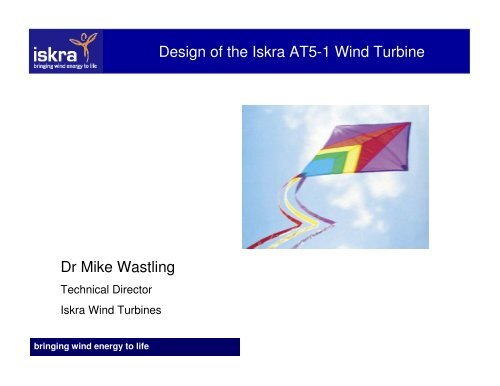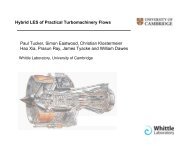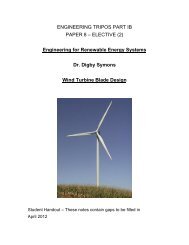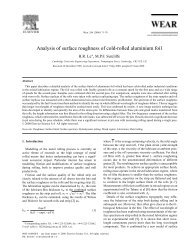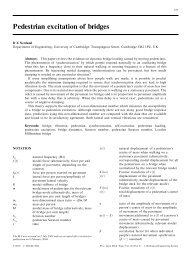Design of the Iskra AT5-1 Wind Turbine Dr Mike Wastling
Design of the Iskra AT5-1 Wind Turbine Dr Mike Wastling
Design of the Iskra AT5-1 Wind Turbine Dr Mike Wastling
You also want an ePaper? Increase the reach of your titles
YUMPU automatically turns print PDFs into web optimized ePapers that Google loves.
<strong>Dr</strong> <strong>Mike</strong> <strong>Wastling</strong><br />
Technical Director<br />
<strong>Iskra</strong> <strong>Wind</strong> <strong>Turbine</strong>s<br />
bringing wind energy to life<br />
<strong>Design</strong> <strong>of</strong> <strong>the</strong> <strong>Iskra</strong> <strong>AT5</strong>-1 <strong>Wind</strong> <strong>Turbine</strong>
Small wind turbines<br />
•Small wind turbines in context<br />
•<strong>Design</strong> considerations<br />
•<strong>Design</strong> constraints<br />
•How <strong>the</strong> turbine configuration is likely to vary with <strong>the</strong> size <strong>of</strong> <strong>the</strong><br />
turbine<br />
The <strong>Iskra</strong> <strong>AT5</strong>-1<br />
•Overview <strong>of</strong> <strong>Iskra</strong> <strong>Wind</strong> <strong>Turbine</strong>s<br />
•Target markets<br />
•<strong>Design</strong> drivers<br />
•Key technology<br />
–Overspeed protection<br />
–Integrated design<br />
bringing wind energy to life<br />
Contents
inging wind energy to life<br />
Small <strong>Wind</strong> in context<br />
• Micro <strong>Wind</strong>: Battery charging, boats, signs<br />
• Small <strong>Wind</strong> (2m to 20m diameter?)<br />
• Large <strong>Wind</strong> - Utility scale electricity generation
Characteristics<br />
• Owner <strong>of</strong> turbine uses <strong>the</strong><br />
electricity (or reduces<br />
consumption)<br />
• Can be grid connected or standalone<br />
• Typical generation shown in table<br />
(typical household consumption<br />
4000 kWhrs per year)<br />
bringing wind energy to life<br />
Small <strong>Wind</strong><br />
Diameter<br />
2m<br />
5m<br />
10m<br />
Typical<br />
rated<br />
power<br />
1kW<br />
5kW<br />
20kW<br />
Annual<br />
Energy<br />
Yield<br />
(kWhrs)<br />
1000 –<br />
2000<br />
6000 –<br />
12000<br />
24000 -<br />
48000
• Generate electricity<br />
bringing wind energy to life<br />
Small <strong>Wind</strong> Applications<br />
– Grid connected – reduce or eliminate electricity consumption and sell<br />
surplus. Homes, schools, farms, community centres. The value <strong>of</strong><br />
<strong>the</strong> displaced electricity consumption is at <strong>the</strong> electricity ‘buy’ price.<br />
– Stand alone – use instead <strong>of</strong> mains electricity – needs battery bank<br />
and probably diesel / Photo Voltaic backup. More expensive, but<br />
higher value. Remote homes, remote communities,<br />
telecommunications.<br />
• O<strong>the</strong>r applications<br />
– Water heating<br />
– Ground source heat pumps<br />
– Water pumping
inging wind energy to life<br />
Worldwide<br />
• There are over two billion people in remote rural communities<br />
without electrical power<br />
• Enormous potential for <strong>the</strong> establishment <strong>of</strong> clean energy<br />
sources for health clinics, water pumping, desalination,<br />
refrigeration <strong>of</strong> medicines, telecommunications, battery<br />
charging as well as heating and lighting.<br />
• Avoid punitive imported fuel costs
inging wind energy to life<br />
Small <strong>Wind</strong> <strong>Turbine</strong> Applications - Constraints<br />
• Needs open spaces with<br />
clear wind (Rural not Urban).<br />
Houses can reduce wind<br />
speeds for about 20 x height<br />
• Noise: require about 50m to<br />
owners house and 100m to<br />
neighbour.<br />
• Shadow flicker: require<br />
about 50m between turbine<br />
at windows West, through<br />
North to East.<br />
25m 50m<br />
N
• Primary consideration<br />
bringing wind energy to life<br />
Energy Yield<br />
<strong>Design</strong> considerations<br />
Cost turbine + Cost Installation + Cost Maintenance + Cost making sales<br />
These costs fairly insensitive to size <strong>of</strong> turbine<br />
Note: Efficiency <strong>of</strong> energy conversion is not a primary<br />
consideration
inging wind energy to life<br />
O<strong>the</strong>r considerations<br />
• Aes<strong>the</strong>tics and noise considerations pretty much dictate need<br />
for slow tip speed, and use <strong>of</strong> 3-blades. (Despite cost<br />
penalty).<br />
• In <strong>the</strong> UK, grid connection is more straightforward for less<br />
than 10kW rated power.<br />
• Ability <strong>of</strong> customer to pay!
• Energy yield and thrust load<br />
are roughly proportional to<br />
swept area (D 2 )<br />
• Treating <strong>the</strong> blades and tower<br />
as simple beams, and scaling<br />
all dimensions in proportion to<br />
D, you find that stress remains<br />
about <strong>the</strong> same, but mass<br />
changes with D 3 .<br />
(Neglects self-weight, which<br />
becomes more important for<br />
large D)<br />
bringing wind energy to life<br />
<strong>Wind</strong> turbine scaling<br />
Thrust<br />
Blade and<br />
tower are<br />
beams
• Theoretically,<br />
small turbines can<br />
use much less<br />
material in <strong>the</strong>ir<br />
manufacture<br />
relative to <strong>the</strong>ir<br />
energy yield.<br />
• Not <strong>the</strong>re yet!<br />
bringing wind energy to life<br />
Mass <strong>of</strong> turbine per MWhr per year<br />
(kg/MWh/yr)<br />
<strong>Wind</strong> turbine scaling<br />
Necessarily crude control<br />
and protection systems,<br />
manufacturing restrictions,<br />
low parts count<br />
30<br />
<strong>Iskra</strong> <strong>AT5</strong>-1 5.5m<br />
diameter, typical<br />
8.7MWhrs/yr, 0.3 tonnes<br />
5.5<br />
<strong>Turbine</strong> diameter (m)<br />
Sophisticated<br />
control and<br />
protection systems<br />
Theoretical line from<br />
simple scaling law<br />
Vestas v90, 90m,<br />
typical<br />
3500MWhr/year,<br />
111tonnes<br />
90
Power (kW)<br />
Time (hrs), Energy<br />
available (kWhrs)<br />
500<br />
400<br />
300<br />
200<br />
100<br />
0<br />
1<br />
2000<br />
1500<br />
1000<br />
500<br />
0<br />
5<br />
1<br />
6<br />
9<br />
Power available to wind turbine<br />
bringing wind energy to life<br />
13<br />
17<br />
21<br />
25<br />
29<br />
wind speed<br />
33<br />
37<br />
41<br />
Energy available to wind turbine<br />
wind speed (m/s)<br />
11<br />
16<br />
21<br />
26<br />
31<br />
36<br />
41<br />
<strong>Design</strong> Challenges<br />
Power (W)<br />
Time at wind speed<br />
hours/year<br />
Energy per year<br />
(kWhr/yr)<br />
Power available to <strong>the</strong> wind<br />
turbine increases with wind<br />
speed cubed.<br />
The energy available to <strong>the</strong><br />
wind turbine is virtually all<br />
below 20m/s (Example<br />
based on 7m/s annual mean<br />
wind speed)<br />
Challenge is to be efficient at<br />
low wind speeds, and shed<br />
power and loads in strong<br />
winds. Solution must be<br />
totally reliable.
Power available to turbine is<br />
proportional to wind speed 3<br />
Maximum thrust proportional<br />
to wind speed 2<br />
Limiting rotor speed is almost<br />
as effective as parking <strong>the</strong><br />
rotor<br />
bringing wind energy to life<br />
Protection against excessive loading<br />
Thrust (N)<br />
x 104 Importance<br />
4.5<br />
4<br />
3.5<br />
3<br />
2.5<br />
2<br />
1.5<br />
1<br />
0.5<br />
<strong>of</strong> over speed protection<br />
Freewheeling<br />
-15 degrees pitch, 250rpm<br />
parked<br />
0<br />
0 10 20 30<br />
wind speed (m/s)<br />
40 50 60
Do nothing –<br />
make it strong!<br />
Micro wind<br />
Crude systems to minimise<br />
parts count<br />
bringing wind energy to life<br />
Furling, or tilting rotor<br />
How to shed surplus power?<br />
Passive blade pitch control<br />
Electrical or mechanical brake<br />
Active pitch control<br />
<strong>Wind</strong> speed monitoring and<br />
automatic shutdown<br />
Mechanical brake backup<br />
Large wind<br />
Sophisticated systems, to<br />
minimise loads and save<br />
weight. Can bear maintenance<br />
costs
• Furling:<br />
– Likely to be misaligned<br />
in light winds (noisy,<br />
reduced energy)<br />
– Will be misaligned in<br />
strong winds (noisy,<br />
high cyclic loads, rapid<br />
yawing loads)<br />
– Since thrust loading is<br />
linked to power divided<br />
by wind speed, furling<br />
speed depends on<br />
wind speed. <strong>Wind</strong><br />
turbine can still over<br />
speed in light winds,<br />
when <strong>of</strong>f-load<br />
bringing wind energy to life<br />
Over speed protection - furling<br />
rotor<br />
Preloaded hinge against stop<br />
Yaw axis<br />
Tail vane
• Use centrifugal load to pitch blades to<br />
reduce efficiency<br />
• Need preloaded spring or equivalent<br />
• Fixed pitch at all times below rated power<br />
• Aligned with wind direction at all times<br />
• Since pitch system has low inertia, so<br />
response is rapid<br />
• Easier to get it wrong!<br />
bringing wind energy to life<br />
Passive pitch regulation<br />
Efficient below<br />
rated power<br />
Minimise<br />
fluctuations in<br />
load in high winds
Fixed configuration<br />
Air-X<br />
bringing wind energy to life<br />
Over speed protection - examples<br />
Furling<br />
Bergey XL-1<br />
Passive pitch<br />
<strong>Iskra</strong> <strong>AT5</strong>-1
• The Company<br />
• Overview <strong>of</strong> <strong>the</strong> turbine<br />
• The pitch system<br />
• The generator<br />
bringing wind energy to life<br />
The <strong>Iskra</strong> <strong>AT5</strong>-1
inging wind energy to life<br />
<strong>Iskra</strong> - The Company<br />
• Concepts 1998<br />
• Company founded Feb 1999<br />
• DTI support 2000<br />
• Prototype 2001<br />
• 1st customer 2004<br />
• Significant investor 2005<br />
• 50 th turbine 2006<br />
• VC investment 2007<br />
• 100 th turbine imminent
inging wind energy to life<br />
The <strong>Iskra</strong> <strong>AT5</strong>-1 - overview<br />
Key design features<br />
1. Passive pitch control for over-speed<br />
protection in high winds and efficient<br />
operation in light winds.<br />
2. Efficient aerodynamic blade shape,<br />
designed to maximise <strong>the</strong> ratio <strong>of</strong><br />
energy yield to loads (i.e. low cost <strong>of</strong><br />
energy), and to achieve low noise.<br />
3. Integrated direct-drive permanent<br />
magnet generator, for low component<br />
count and reduced mass/cost.<br />
4. A sleek and slender design for low<br />
visual impact.
inging wind energy to life<br />
Overview
Feature<br />
•Blade normally fixed at optimum<br />
pitch<br />
•Centrifugal loads pitch to stall to<br />
shed surplus power and regulate<br />
speed<br />
•Aerodynamic torque delays<br />
power shedding in <strong>the</strong> presence<br />
<strong>of</strong> generator reaction torque<br />
•Blades are all linked in pitch<br />
•Distributed/balanced loads<br />
minimise hub deflections<br />
•Rotor is always aligned with <strong>the</strong><br />
wind<br />
bringing wind energy to life<br />
Means that:<br />
Energy capture not<br />
compromised<br />
Pitch system<br />
Effective <strong>of</strong>f-load and high<br />
wind speed rpm regulation<br />
Maximum over speed can<br />
be comparable to normal<br />
running speed<br />
Rotor is always mass and<br />
aerodynamically balanced<br />
Makes it much easier to<br />
integrate hub/generator<br />
Minimise cyclic aerodynamic<br />
noise<br />
Minimise cyclic loads<br />
Centrifugal<br />
Aero torque<br />
Loads balanced<br />
Pitch axis<br />
Loads<br />
distributed
Feature<br />
High efficiency, purpose built direct<br />
drive generator<br />
Air cored – no magnetic attraction<br />
between stator and rotor<br />
Single hub plate for structure and<br />
flux<br />
Innovative arrangement <strong>of</strong> coils*<br />
*patented<br />
bringing wind energy to life<br />
Means that:<br />
Generator<br />
High value from extra energy<br />
compared to extra cost <strong>of</strong> magnets<br />
and copper.<br />
Easy to cool<br />
Easy to achieve large diameter, so<br />
much reduced need for stiff<br />
structure/bearings<br />
Low component count/cost<br />
Reduce eddy current losses, and<br />
no need for laminated rotor<br />
Effective cooling<br />
Air cored<br />
stator<br />
Magnets<br />
Structural hub
inging wind energy to life<br />
Summary<br />
Small wind turbines in context<br />
<strong>Design</strong> considerations<br />
<strong>Design</strong> constraints<br />
How <strong>the</strong> turbine configuration is likely<br />
to vary with <strong>the</strong> size <strong>of</strong> <strong>the</strong> turbine<br />
The <strong>Iskra</strong> <strong>AT5</strong>-1<br />
The company<br />
Target markets<br />
<strong>Design</strong> drivers<br />
Key technology


